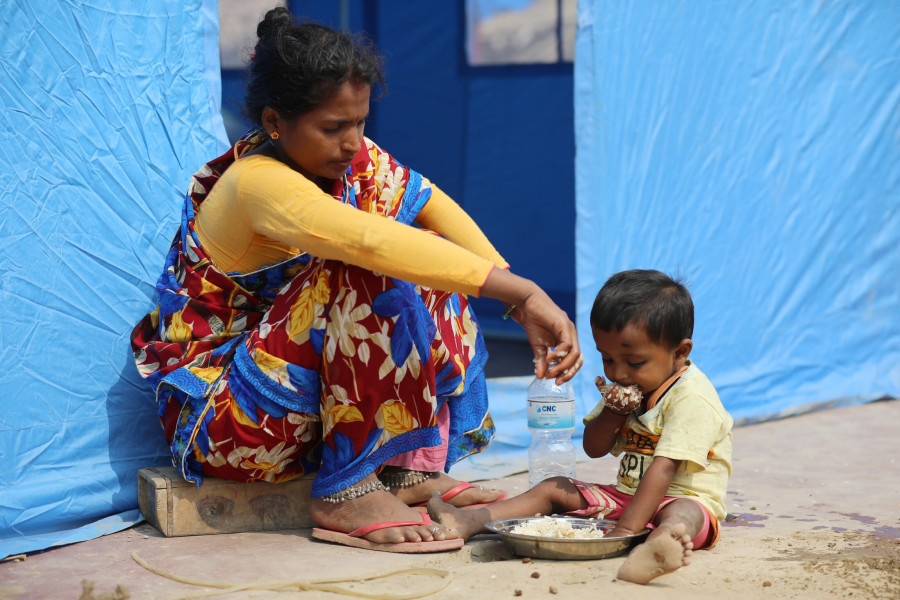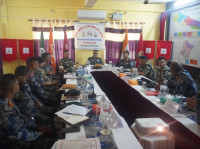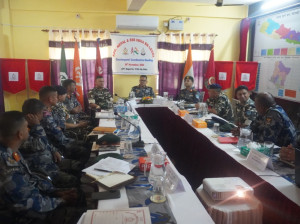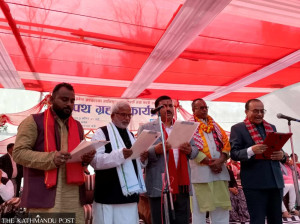Madhesh Province
Government says it will rebuild homes for windstorm victims before monsoon
After days of the devastating windstorm that struck Bara and Parsa districts in the southern plains, the central government has said it will move ahead with the reconstruction of the affected areas trying to recover from the disaster.
Chandan Kumar Mandal
After days of the devastating windstorm that struck Bara and Parsa districts in the southern plains, the central government has said it will move ahead with the reconstruction of the affected areas trying to recover from the disaster.
The Disaster Risk Reduction and Management Executive Committee meeting, chaired by Home Minister Ram Bahadur Thapa, on Friday reached a decision to immediately swing into the reconstruction phase.
During the meeting, which was attended by ministry secretaries and focal persons of different humanitarian clusters, Thapa directed all the stakeholders to work in “integrated approach”, according to Bed Nidhi Khanal, chief of National Emergency Operation Centre.
“The minister has instructed all the agencies to work in close coordination to implement the decision of providing survivors with settlements before monsoon,” Khanal told the Post.
The responsibility of building new housing projects for the windstorm-affected families is being handed to the Army.Meanwhile, the government has started collecting on-the-ground details from the disaster-hit settlements.
A meeting of various clusters on Wednesday evening analysed the situation so far on the ground after the deadly windstorm, the strongest ever recorded in the country’s history, that wreaked havoc in various parts of the two districts, claiming at least 28 lives and leaving thousands of people homeless.
The meeting between focal persons on three clusters – logistics, nutrition and food and security – at the Home Ministry concluded that the situation has mostly returned to normalcy in majority of the places, according to Khanal, chief of the National Emergency Operation Centre.
“We assessed the condition of various sectors or clusters and discussed how to move ahead to address the problems in these sectors,” Khanal told the Post. “For the early recovery and post-disaster recovery, we have completed the situation update.
We also discussed how we can perform rest of the activities in coordination with all three tiers of the government.”
The late evening windstorm that battered parts of 10 rural municipalities and municipalities in the two districts damaged 1,895 houses, forcing the disaster survivors of all ages to spend the first two nights under the open skies.
Even though the cluster meeting concluded that there was enough logistics on the ground in the aftermath of the disaster, there was still a lack of temporary shelters and cooking utensils in the disaster-hit areas.
“Besides the need of more tarpaulins and other items, there is a scarcity of lights as power supply is yet to resume because most of the electric poles were uprooted by the high-speed storm,” added Khanal.
The meeting has decided to request the Ministry of Energy, Water Resources, and Irrigation to send 500 solar lights to the windstorm-affected areas. Likewise, the meeting has also requested UNICEF to send mosquito nets for the families in the two districts.
Other UN agencies are already sending medical kits and other hygiene related items, according to Khanal. Health experts have warned that the disaster-affected areas has become prone to disease outbreak. Poor hygiene, scarcity of clean drinking water and hygienic food and sleeping outdoors might result in survivors contracting various diseases mostly water-borne diseases.
“The nutrition cluster has thought of providing the survivors with vitamin supplements after inspecting them in the villages and also in the hospitals,” said Khanal. “The area does not have any shortage of food as edible items are being regularly distributed by various government and non-government agencies as well as clubs and individuals since the day the disaster struck.”
“Food items are enough. The problem has been in management of food supply chain as even those not affected by disaster have queued up for relief materials meant for actual survivors.”




 10.12°C Kathmandu
10.12°C Kathmandu














